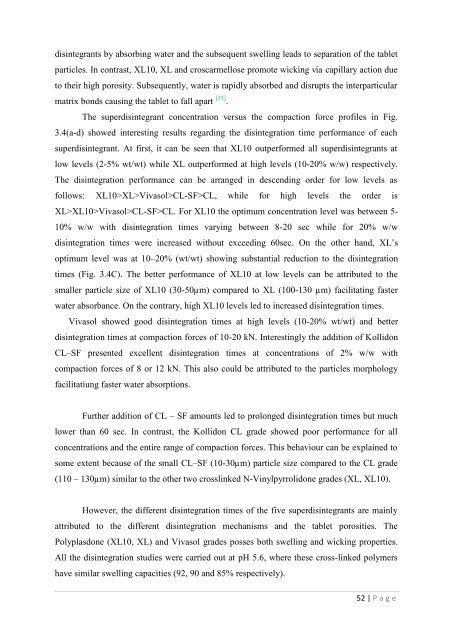Development of hot-melt extrusion as a novel technique for the ...
Development of hot-melt extrusion as a novel technique for the ...
Development of hot-melt extrusion as a novel technique for the ...
You also want an ePaper? Increase the reach of your titles
YUMPU automatically turns print PDFs into web optimized ePapers that Google loves.
disintegrants by absorbing water and <strong>the</strong> subsequent swelling leads to separation <strong>of</strong> <strong>the</strong> tabletparticles. In contr<strong>as</strong>t, XL10, XL and croscarmellose promote wicking via capillary action dueto <strong>the</strong>ir high porosity. Subsequently, water is rapidly absorbed and disrupts <strong>the</strong> interparticularmatrix bonds causing <strong>the</strong> tablet to fall apart [33] .The superdisintegrant concentration versus <strong>the</strong> compaction <strong>for</strong>ce pr<strong>of</strong>iles in Fig.3.4(a-d) showed interesting results regarding <strong>the</strong> disintegration time per<strong>for</strong>mance <strong>of</strong> eachsuperdisintegrant. At first, it can be seen that XL10 outper<strong>for</strong>med all superdisintegrants atlow levels (2-5% wt/wt) while XL outper<strong>for</strong>med at high levels (10-20% w/w) respectively.The disintegration per<strong>for</strong>mance can be arranged in descending order <strong>for</strong> low levels <strong>as</strong>follows: XL10>XL>Viv<strong>as</strong>ol>CL-SF>CL, while <strong>for</strong> high levels <strong>the</strong> order isXL>XL10>Viv<strong>as</strong>ol>CL-SF>CL. For XL10 <strong>the</strong> optimum concentration level w<strong>as</strong> between 5-10% w/w with disintegration times varying between 8-20 sec while <strong>for</strong> 20% w/wdisintegration times were incre<strong>as</strong>ed without exceeding 60sec. On <strong>the</strong> o<strong>the</strong>r hand, XL‘soptimum level w<strong>as</strong> at 10–20% (wt/wt) showing substantial reduction to <strong>the</strong> disintegrationtimes (Fig. 3.4C). The better per<strong>for</strong>mance <strong>of</strong> XL10 at low levels can be attributed to <strong>the</strong>smaller particle size <strong>of</strong> XL10 (30-50µm) compared to XL (100-130 µm) facilitating f<strong>as</strong>terwater absorbance. On <strong>the</strong> contrary, high XL10 levels led to incre<strong>as</strong>ed disintegration times.Viv<strong>as</strong>ol showed good disintegration times at high levels (10-20% wt/wt) and betterdisintegration times at compaction <strong>for</strong>ces <strong>of</strong> 10-20 kN. Interestingly <strong>the</strong> addition <strong>of</strong> KollidonCL–SF presented excellent disintegration times at concentrations <strong>of</strong> 2% w/w withcompaction <strong>for</strong>ces <strong>of</strong> 8 or 12 kN. This also could be attributed to <strong>the</strong> particles morphologyfacilitatiung f<strong>as</strong>ter water absorptions.Fur<strong>the</strong>r addition <strong>of</strong> CL – SF amounts led to prolonged disintegration times but muchlower than 60 sec. In contr<strong>as</strong>t, <strong>the</strong> Kollidon CL grade showed poor per<strong>for</strong>mance <strong>for</strong> allconcentrations and <strong>the</strong> entire range <strong>of</strong> compaction <strong>for</strong>ces. This behaviour can be explained tosome extent because <strong>of</strong> <strong>the</strong> small CL–SF (10-30µm) particle size compared to <strong>the</strong> CL grade(110 – 130µm) similar to <strong>the</strong> o<strong>the</strong>r two crosslinked N-Vinylpyrrolidone grades (XL, XL10).However, <strong>the</strong> different disintegration times <strong>of</strong> <strong>the</strong> five superdisintegrants are mainlyattributed to <strong>the</strong> different disintegration mechanisms and <strong>the</strong> tablet porosities. ThePolypl<strong>as</strong>done (XL10, XL) and Viv<strong>as</strong>ol grades posses both swelling and wicking properties.All <strong>the</strong> disintegration studies were carried out at pH 5.6, where <strong>the</strong>se cross-linked polymershave similar swelling capacities (92, 90 and 85% respectively).52 | P a g e
















